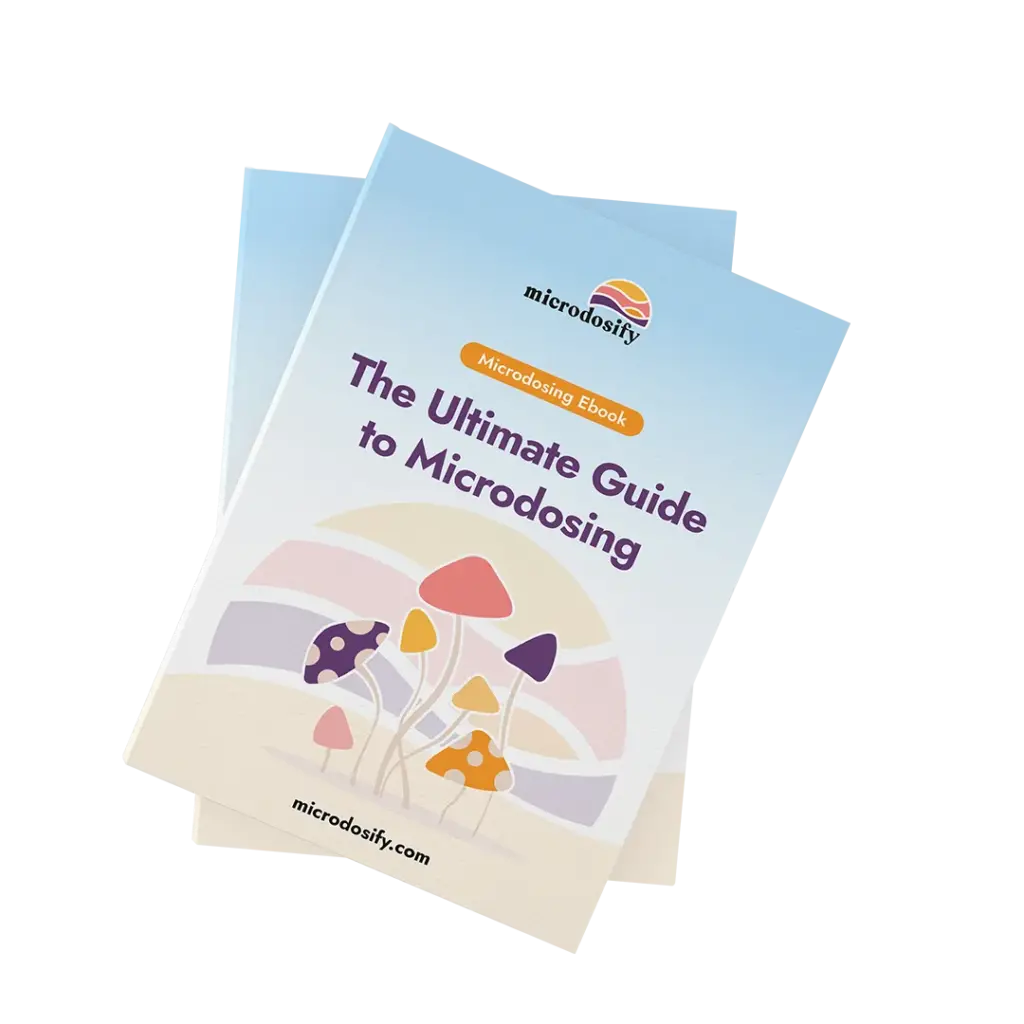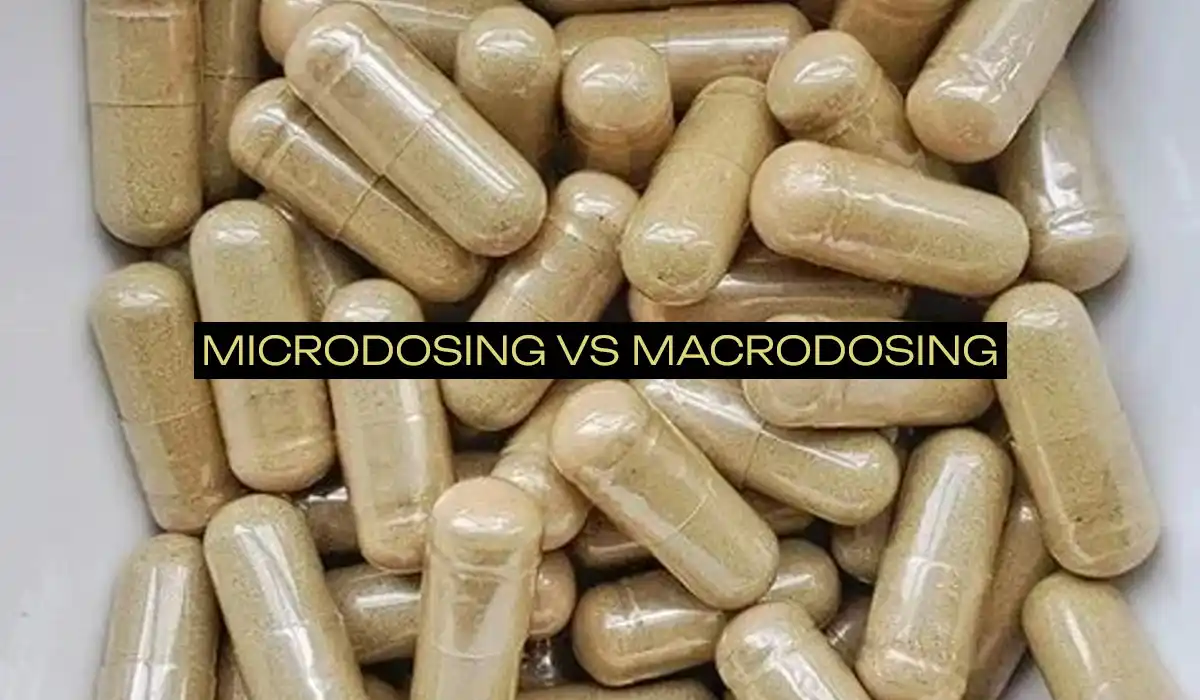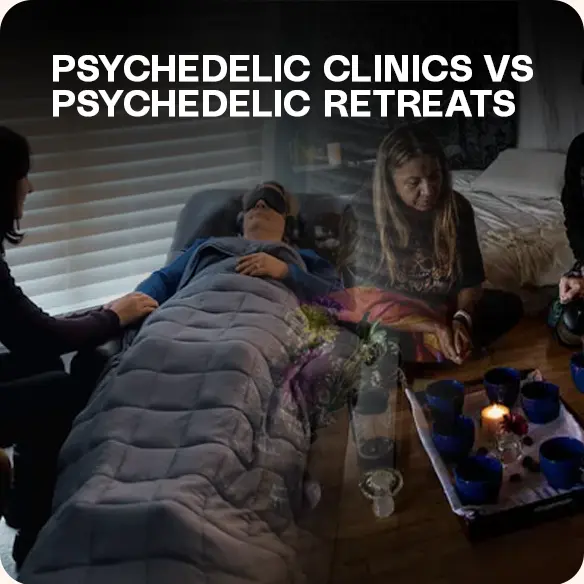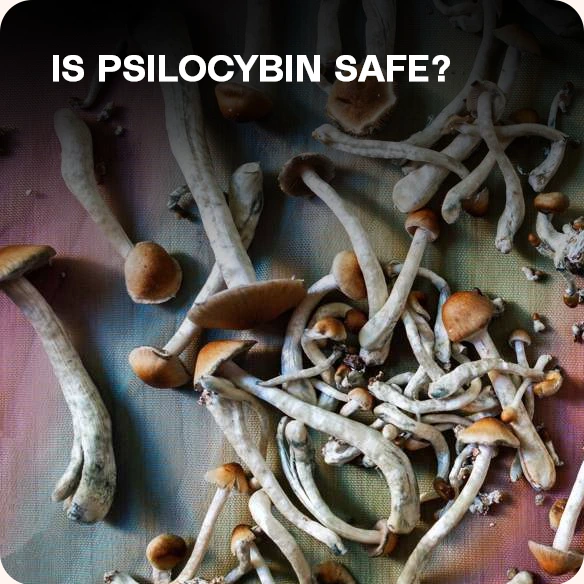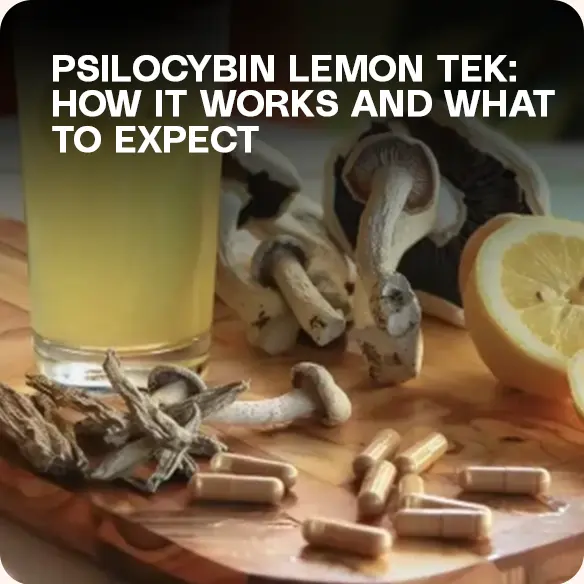Microdosing involves taking very small, regular amounts of psychedelic substances like psilocybin to subtly enhance mental well-being, while macrodosing uses larger doses to induce profound psychedelic experiences for deep emotional and spiritual insights.
This article will describe how different doses influence perception, mood, and cognitive states.
This article covers the key differences between microdosing vs macrodosing, their benefits, risks, and how each approach supports healing and personal growth through therapeutic effects.
In this article, you will learn:
- What microdosing and macrodosing are and how they differ in practice.
- The types of psychedelic substances used in each approach.
- The mental health benefits and potential risks associated with both.
- How psilocybin therapy fits into these practices.
- Guidance on choosing the right approach based on individual goals.
- The key differences in effects between microdosing’s subtle benefits and macrodosing’s profound experiences.
- The importance of dosage, set, and setting for safe and effective psychedelic use.
- Current scientific understanding of the efficacy and safety of microdosing and macrodosing.
- How to determine which dosing strategy aligns best with personal mental health and growth goals.
What is Microdosing?
Microdosing involves taking sub-perceptual amounts of psychedelic substances, such as psilocybin mushrooms, to improve mental clarity and emotional balance without causing intense psychedelic effects.
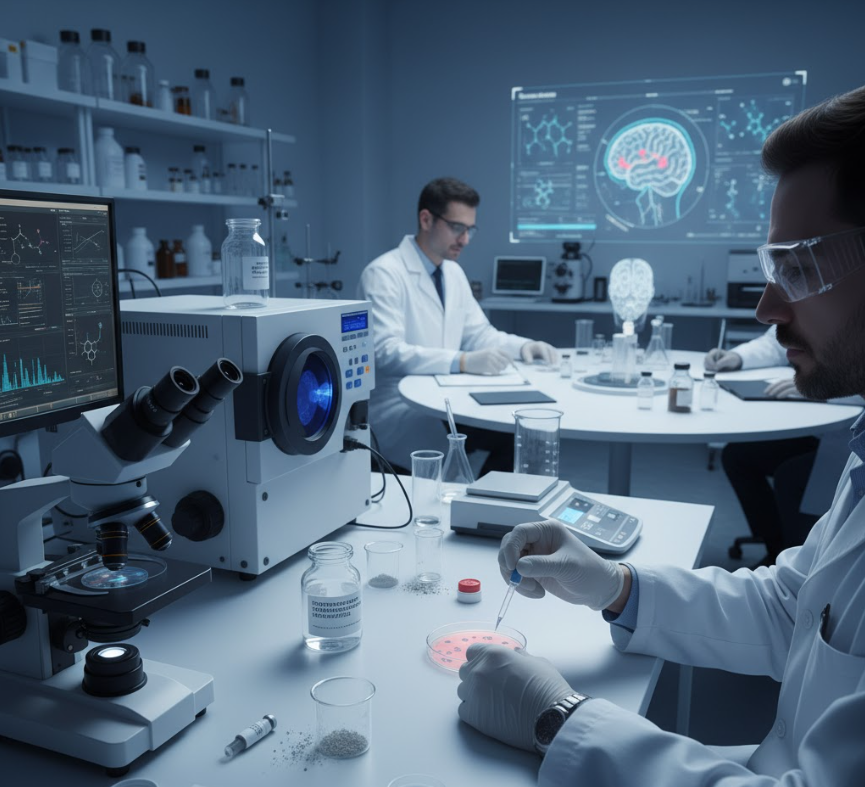
This practice supports gradual personal growth and mental health enhancement through subtle shifts in consciousness and enhanced creativity.
For those exploring this mindful approach, Microdosify offers carefully formulated options like Calm and Create, designed to support focus, creativity, and emotional well-being through responsible microdosing.
What Substances Are Used for Microdosing?
Microdosing primarily involves psychoactive substances like psilocybin mushrooms and lysergic acid diethylamide (LSD), chosen for their potential therapeutic effects without causing strong psychedelic experiences.
A microdose refers to a small, sub-perceptual amount of a psychedelic substance, typically used to achieve subtle benefits without noticeable intoxication.
Psilocybin mushrooms contain psilocin, which interacts with serotonin receptors, while LSD is a synthetic compound that affects perception and cognition.
Both substances, when carefully dosed, may enhance creativity, focus, and mood with a favorable safety profile under professional guidance. Drug safety and tolerability remain key considerations when selecting substances for microdosing.
Common Substances for Microdosing:
- Psilocybin Mushrooms — natural fungi containing compounds that promote mental clarity and emotional balance.
For those exploring this approach responsibly, see Microdosify’s psilocybin-inspired blends that align with microdosing principles of clarity and creativity. - LSD — a synthetic psychedelic known for its potent effects on perception and cognition, often used in research settings.
Microdosing practice favors these substances due to their low risk of adverse effects (when used responsibly) and their potential to support focus, resilience, and emotional well-being.
How is Microdosing Different from Regular Dosing?
Microdosing entails consuming a fraction of a typical psychedelic dose, producing subtle cognitive and emotional benefits without intense effects.
In contrast, a higher dose produces more intense effects compared to a microdose, often resulting in a more pronounced alteration of consciousness.
It aims to improve daily functioning, mood stability, and creativity without significantly altering perception.
Macrodosing delivers a full dose that induces profound changes in consciousness, including vivid hallucinations, facilitating emotional healing and spiritual exploration.
While microdosing supports mental health and self-improvement, macrodosing enables deep psychological breakthroughs. The effectiveness of each approach can vary depending on dosage and individual context.
Placebo-controlled scientific studies are necessary to confirm microdosing’s true efficacy. More research is also needed to determine the effectiveness of both microdosing and higher dose approaches.
What is Psychedelic Use?
Psychedelic substances like magic mushrooms have gained recognition for supporting mental health, especially in treating mental illness such as depression and anxiety through psilocybin therapy.
Psychiatry is increasingly exploring the therapeutic potential of psychedelics, with clinical studies highlighting their role in psychedelic-assisted therapies for conditions like anxiety, depression, and obsessive-compulsive disorder.
Psilocybin promotes brain plasticity and new neural connections, improving emotional awareness and cognitive flexibility.
Despite growing scientific research, risks such as psychological discomfort and adverse effects exist, especially without professional supervision.
Proper preparation and guidance ensure safe use and maximize beneficial effects. These practices are now being integrated into new therapeutic approaches and therapies for mental health, expanding options beyond traditional treatments.
Psilocybin Therapy and Magic Mushrooms
Psilocybin therapy uses higher doses of psilocybin mushrooms to induce deep personal insights and reduce symptoms of depression and anxiety.
Systematic reviews and clinical trials demonstrate psilocybin’s potential in improving mood and well-being. Additionally, a recent review of the literature supports these findings.
Ongoing scientific research aims to determine optimal dosages and protocols due to individual variability in responses.
Evidence-based psilocybin therapy ensures safe, effective treatment for mental illness.
What is Psilocybin’s Potential for Treatment?
Psilocybin, the primary psychoactive compound found in magic mushrooms, is at the forefront of a new wave of scientific research into mental health treatments.
As a psychedelic substance, psilocybin from magic mushrooms has shown promising therapeutic effects for a range of mental illnesses, including depression and anxiety, especially in patients who have not responded to traditional medications.
How Psilocybin Helps the Mind?
Recent studies show that psilocybin therapy, especially at higher doses, can help:
- Lift mood and reduce anxiety
- Ease symptoms of depression
- Encourage creativity and emotional openness
These effects are most noticeable in controlled settings, where therapy helps people process emotions and gain long-lasting mental clarity.
What Happens with Small Doses (Microdosing)?
People who microdose often report:
- Feeling calmer and more balanced
- Better creativity and focus
- Subtle personal growth over time
For those exploring microdosing safely and responsibly, Microdosify offers gentle, well-formulated options such as:
- Calm Microdosing Capsules – for stress relief and mental balance
- Create Microdosing Capsules – for creativity, clarity, and flow
These blends reflect the purpose of microdosing — gradual, balanced improvement without intense effects.
While results are encouraging, researchers are still studying microdosing to confirm its long-term benefits and safety.
What Happens with Larger Doses (Macrodosing)?
Higher doses of psilocybin create more powerful experiences that can lead to deep emotional healing and self-discovery.
People who take larger doses under supervision may experience:
- Emotional breakthroughs and healing from trauma
- New insights about life and purpose
- Strong feelings of connection and peace
How It Differs from LSD?
LSD (lysergic acid diethylamide) is another psychedelic sometimes used in research.
However, compared to psilocybin, LSD tends to:
- Last longer and feel more intense
- Carry a higher risk of “bad trips”
- Require careful supervision for safety
That’s why guided, professional support is important in both cases.
Why the Right Dose and Setting Matter?
Psilocybin affects everyone differently. For best results, it’s important to consider:
- Dosage – how much you take
- Setting – where and with whom you take it
- Guidance – whether it’s done with professional support
These factors can make the difference between a safe, healing experience and an uncomfortable one.
The Future of Psilocybin Therapy
As research continues, laws and medical guidelines are slowly changing to recognize psilocybin’s potential benefits.
Scientists are learning that:
- Psilocybin therapy can help with treatment-resistant depression and anxiety
- Proper supervision ensures safety
- Evidence-based approaches are key to responsible use
Psilocybin shows strong potential as a tool for mental health and personal growth.
With continued research and responsible use, psilocybin therapy may offer new hope for people struggling with depression, anxiety, and other conditions—marking a major step forward in modern mental health care.
What is Microdosing Psychedelics for Daily Life?
Microdosing involves small amounts of psilocybin taken regularly to enhance daily life without intense psychedelic effects.
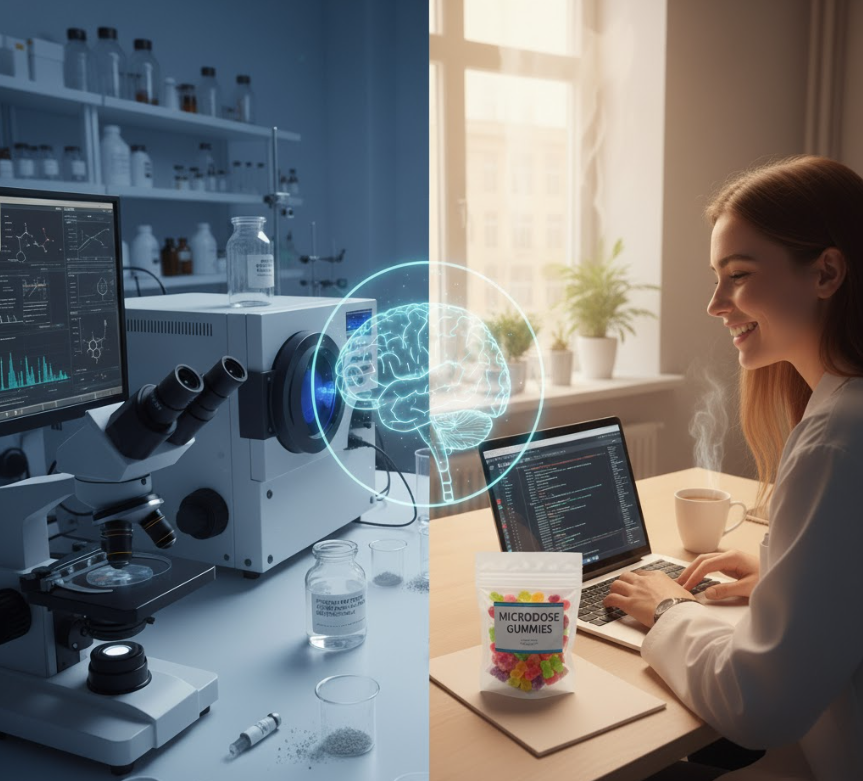
Users report improved mood, increased energy, focus, and creativity, supporting subtle yet meaningful routine changes. Recent discussions also highlight psilocybin’s potential to support mental well-being and daily functioning.
Long-term safety and efficacy require more research.
Starting with low doses and prioritizing safety is essential.
Scientific studies suggest that microdosing may offer several mental health and cognitive benefits, including:
- Improved mood and emotional balance
- Sharper focus and concentration
- Increased creativity and problem-solving ability
These potential benefits make microdosing appealing for those seeking therapeutic support without the intense effects of full psychedelic experiences.
For individuals exploring this approach mindfully, Calm Microdosing Capsules from Microdosify are designed to complement a balanced lifestyle — supporting focus, clarity, and emotional well-being in a gentle, structured way.
Improved Mood and Mental Well-being
Microdosing improves mood and emotional stability, reducing anxiety and depression symptoms.
Users report increased positivity, motivation, and emotional balance, enhancing daily life.
Research supports enhanced emotional regulation and cognitive flexibility.
- Impact: Heightened creativity, reduced stress, and improved outlook.
- Therapeutic Use: Expanding applications in mental health treatments.
Increased Focus and Creativity
Microdosing enhances focus and creativity, enabling expansive thinking and problem-solving.
Studies indicate improved cognitive processes and productivity.
Users experience heightened awareness, facilitating personal growth.
Examples include sharper focus in university studies and increased emotional resilience.
Enhanced Spiritual and Emotional Insights
Microdosing fosters spiritual and emotional insights, boosting self-awareness and personal growth.
It helps users gain new perspectives on emotions and spirituality, aiding emotional healing.
These experiences support confronting past trauma safely and encourage deeper spiritual journeys.
What are the Benefits of Macrodosing?
Macrodosing provides intense psychedelic experiences that enable therapeutic breakthroughs and deep emotional healing.

Research explores macrodosing’s potential in treating depression, PTSD, and anxiety.
Intense Psychedelic Experience
Macrodosing induces vivid hallucinations, altered time perception, and a sense of universal connection.
Users confront personal trauma and fears, often leading to emotional breakthroughs.
Heightened empathy and lasting perspective shifts contribute to improved mental health.
Potential for Therapeutic Breakthroughs
Macrodosing facilitates emotional release, introspection, and strengthened connections with others.
These experiences enable healing previously thought unattainable.
Spiritual and Emotional Growth
Macrodosing promotes profound spiritual growth and self-understanding.
Research highlights neuroplasticity effects that support emotional resilience.
Participants report clarity, purpose, and stronger relationships following macrodosing.
What are the Side Effects of Microdosing and Macrodosing?
Both microdosing and macrodosing can cause physical discomfort and psychological distress; risk of addiction appears low but should be monitored.
Safe use hinges on careful dosing, preparation, and support.
Addiction risk is low but should be monitored.
Managing side effects and ensuring safe use remain challenges.
Physical Side Effects
Physical effects include nausea, increased heart rate, temperature changes, and gastrointestinal issues.
Monitoring bodily responses maximizes benefits and minimizes discomfort.
Psychological Side Effects
Psychological effects may include anxiety and emotional distress, intensified by psychedelic intensity.
Preparation, safe environments, and mindfulness reduce adverse effects.
Professional support is recommended for distressing experiences.
Therapeutic Settings and Retreats
Therapeutic settings and retreats provide structured environments with medical professionals guiding psilocybin and other psychedelic substance use.
Set and setting critically influence treatment outcomes.
Well-designed environments promote safety, support, and healing.
Growing interest has increased availability of clinical programs and retreats.
Microdosing or Macrodosing: Which One is Right for You?
Choosing microdosing or macrodosing depends on mental health goals, desired experience intensity, and readiness for psychedelic therapy.
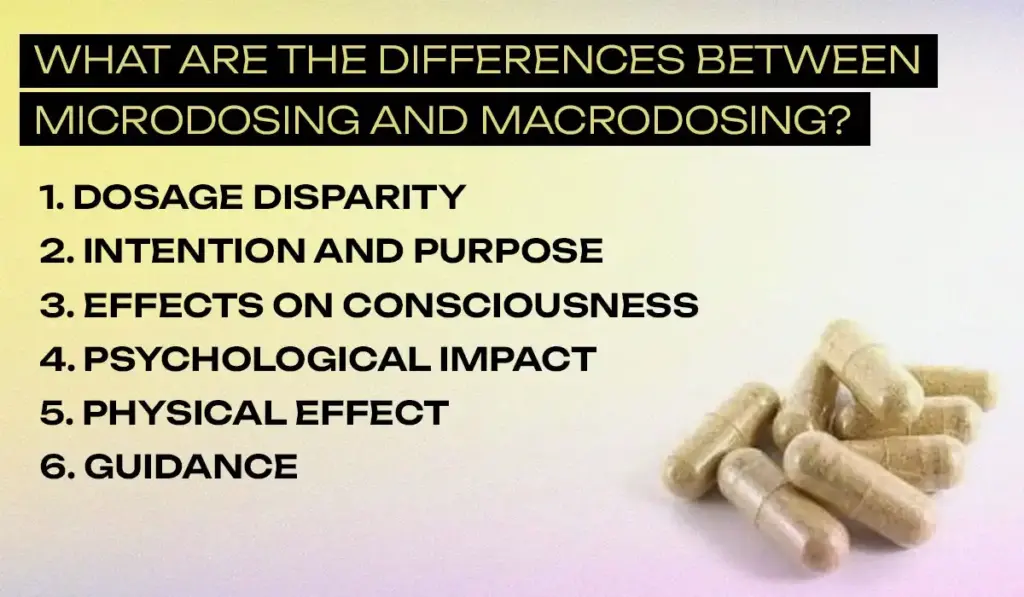
Legal and drug policy considerations affect access and safety.
What are the Factors to Consider when Choosing Between Microdosing and Macrodosing?
Consider mental health objectives, experience intensity, personal history, and dosing schedules.
- Microdosing: Regular, sub-perceptual doses for subtle mood and creativity enhancement.
- Macrodosing: Occasional, high doses for profound insights requiring integration time.
Ready to Explore Mindfully?
If you’re curious about how microdosing can fit into your wellness journey, start by exploring the Microdosify shop for safe, balanced options designed for clarity and focus.
For deeper guidance, consider scheduling a coaching call session to learn how to integrate microdosing practices responsibly and align them with your personal goals. Coaching support helps you:
- Understand dosing schedules and safe practices
- Set clear intentions for your journey
- Integrate your experiences for lasting results
Start small, stay mindful, and explore with purpose — your journey toward mental clarity and emotional growth begins here.
Frequently Asked Questions
What is the difference between microdosing and macrodosing?
Microdosing uses small, sub-perceptual doses; macrodosing uses full doses.
|
Effects |
Microdosing |
Macrodosing |
|
Mental Health Effects |
Minor mood and anxiety improvements; enhanced emotional stability. |
Therapeutic for severe mental illness; reduces depression in controlled settings. |
|
Cognitive Changes |
Increased creativity, focus, and productivity. |
Significant perception and cognition changes; profound self-discovery. |
|
Spiritual Experiences |
Slightly enhanced spiritual awareness and gradual growth. |
Life-changing experiences with increased existential well-being. |
|
Potential Risks |
Low risk with few adverse effects. |
Anxiety, disorientation, and rare long-term psychological discomfort. |
What are the benefits of microdosing compared to macrodosing?
Microdosing enhances creativity, mood, and focus without inducing full psychedelic experiences, making it suitable for daily life.
Is microdosing safer than macrodosing?
Microdosing carries fewer risks due to lower doses but still requires research and professional consultation.
Can I still experience a psychedelic trip with microdosing?
Microdosing does not produce full psychedelic trips; effects are subtle and controlled.
What is the recommended dosing schedule for microdosing?
Common schedules involve small doses every 2-3 days over several weeks to avoid tolerance.
Are there any potential side effects of microdosing and macrodosing?
Side effects include increased heart rate, mood changes, and altered perception; monitoring and professional advice are essential.
